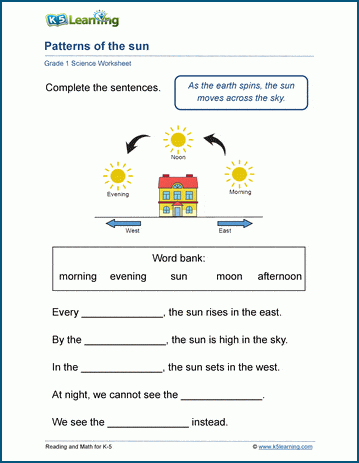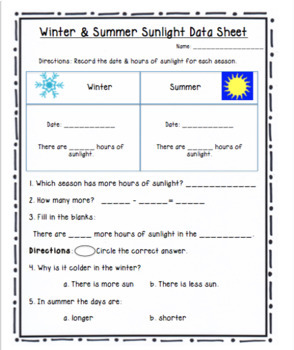And stars other than our sun are visible at night but not during the day. Students who demonstrate understanding can.

Patterns Of The Sun Worksheet K5 Learning
Make observations at different times of.

. Includes Sun and Other Stars lesson plan activity worksheet quiz video reading more. Students observe the sun daily collect data describe the patterns they see and answer XLZPVUZYLSHLKVOLWHLYUZ. First graders ask questions and use observations of the sun moon and stars to describe apparent patterns of change in each.
Mercury goes around the Sun every 88 days. The Universe and its Stars Patterns of the motion of the sun moon and stars in the sky can be observed described and predicted. In this lesson students develop a model of the suns daily path across the sky then use this model to help someone whos lost.
Students make observations of the sun to identify patterns record daily data and make predictions. Students will explore the patterns in the day and night sky. And stars other than our sun are visible at night but not during the day.
1-ESS1-1 Clarification Statement and Assessment Boundary Clarification Statement. Use observations of the sun moon and stars to describe patterns that can be predicted. Bundles are created with potential instructional use in mind based upon potential for related phenomena that can be used throughout a unit.
These patterns are then used to answer questions and make predictions. Get thousands of teacher-crafted activities that sync up with the school year. Students will observe the patterns in seasons the position of the sun and moon phases.
Next Generation of Science Standards NGSS - Grade 1. Patterns of the motion of the sun moon and stars in the sky can be observed described and predicted. Students will observe the Sun and moon to describe patterns that can be predicted.
Patterns include Sun rising moving across the sky sunsetting using shadows to determine the position of the Sun moon phases and more. Every _____ the sun rises in the east. Over the course of the unit students will record observations of sun moon and stars over periods of time.
Patterns of the sun Grade 1 Science Worksheet Complete the sentences. Aug 19 2015 - The unit is 40 pages and includes information about the patterns of the moon sun stars and seasons. Some examples of patterns include.
Sun Daily Patterns Sun Finder. Patterns of the Sun Moon and Stars Standards Bundle Standards are listed within the bundle. Explore the pattern of the sun and how it affects daylight and dark.
Ad The most comprehensive library of free printable worksheets digital games for kids. Sun and Moon Patterns in the Day and Night Sky Performance Expectation for GSE. This video satisfies the 1-ESS1-2 requirement for first grade proficiency.
Student Science Performance Grade or course 2nd Title Topic. Plan your 60-minute lesson in Science with helpful tips from Regan Aymett. At night we cannot see the _____.
The sun and moon appear to rise in one part of the sky move across the sky and set. As the earth spins the sun moves across the sky. 1-ESS1-1 Use observations of the sun moon and stars to describe patterns that can be predicted.
Examples of patterns could include that the sun and moon appear to rise in one part of the sky move across the sky and set. This unit was designed specifically to address the first grade NGSS Earth Science Standards1-ESS1-1. In the activity Sun Finder students create a mobile paper model of the sun and earth to illustrate the position of the sun throughout the day.
Earth makes one turn on its axis every 24 hours. Enjoy and dont forget to learn. Earth and Space Science.
In the _____ the sun sets in the west. By the _____ the sun is high in the sky. We created this unit with the new Common Core science standards in mind.
Use observations of the sun moon and stars to describe patterns that can be predicted. In Unit 1 students study the sun moon and stars through various narrative texts and begin to understand how and why the sun moon and stars inspire authors. Ad Made in partnership with the National Science Teaching Association.
I want students to make sense of the science and understand what is happening t. The Moon goes around Earth every 28 days. 1-ESS1-1 Use observations of the sun moon and stars to describe patterns that can be predicted.
There are resources here that are designed to be used in a first grade classroom as well as resources for second and third. In this unit students will methodically investigate the science of the patterns of the apparent movement of the space objects they can see from Earth. Make observations at different times of year to relate the.
Examples of patterns could include that the sun and moon appear to rise in one part of the sky move across the sky and set. We see the _____ instead. Earth orbits the Sun about every 365 days.
By recording observations of the these object throughout the school year students will learn. This video talks about the patterns of the sun during different times of the year like length of days and much more. Earth and the Solar System Seasonal patterns of sunrise and sunset can be observed described and predicted.
Elvin wants to learn more about the sun moon and stars and shares his wonderings and artifacts he receives along his journey with the first-grade students.

Patterns In Nature Sun Moon Stars Seasons Free Product Patterns In Nature First Grade Science Earth And Space Science

Sun And Stars Vocabulary First Grade First Grade Science Third Grade Science Worksheets 1st Grade Science

1 Ess1 1 The Wonder Of Science

Sun And Moon Patterns Unit By Thefirstgradelife Tpt

Patterns Of The Sun And Daylight 1st Grade Science Ngss 1 Ess1 1 1 Ess1 2

Sky Patterns Sun Moon And Stars Pbs Learningmedia

Patterns Of The Sun And Daylight 1st Grade Science Ngss 1 Ess1 1 1 Ess1 2

First Grade Wow Sunny Sunny Day Objects In The Sky First Grade Science Earth And Space Science 1st Grade Science
0 komentar
Posting Komentar